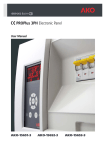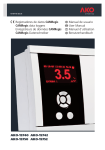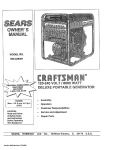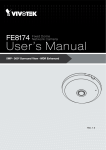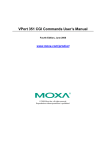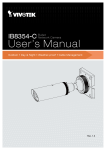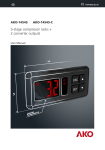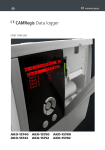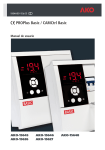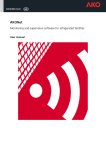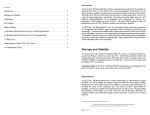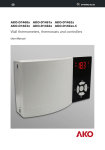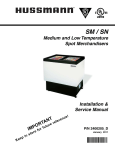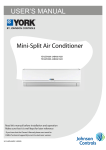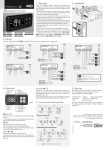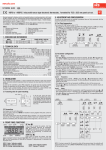Download PROPlus Basic / CAMCtrl Basic
Transcript
1564H502 Ed.03 GB PROPlus Basic / CAMCtrl Basic User Manual AKO-15645 AKO-15626 AKO-15646 AKO-15627 AKO-15648 Index Page 1.- Presentation .......................................................................................................3 1.1.- Versions .................................................................................................3 1.2.- Maintenance ..........................................................................................3 1.3.- Cautions ................................................................................................3 2.- Installation..........................................................................................................4 3.- Wiring ................................................................................................................6 3.1.- Pressure switch wiring options ...............................................................9 4.- Recommendations..............................................................................................10 5.- Connectivity .......................................................................................................11 6.- Description ......................................................................................................12 6.1.- Quick access to functions .....................................................................12 6.2.- Messages .............................................................................................13 7.- Wizard..............................................................................................................14 8.- Basic configuration ...........................................................................................15 9.- Operation .........................................................................................................16 9.1.- Compressor control .............................................................................16 9.2.- Defrost control .....................................................................................18 9.3.- Fan control...........................................................................................19 9.4.- Light control.........................................................................................19 9.5.- Pump down function............................................................................20 9.6.- Alarms .................................................................................................21 9.7.- Trapped person alarm...........................................................................22 9.8.- Access code (password)........................................................................22 9.8.- Parameter transfer................................................................................23 9.9.- Other functions ....................................................................................23 9.10.- Program version .................................................................................24 10.- Advanced configuration....................................................................................24 10.1.- Parameters .........................................................................................25 11.- Technical specifications .....................................................................................29 AKO Electromecánica thanks and congratulates you for purchasing our product, in whose development and manufacture the most innovative technology has been used, as well as strict production and quality control processes. Our commitment to satisfy our customers and our continuous efforts to improve every day can be seen in the various quality certifications we have obtained. This is a high performance, high technology product. The operation and final performance of the equipment depend on proper planning, installation, configuration and commissioning. Read this manual carefully before installation, and always follow its instructions. Only qualified personnel should install or perform technical assistance on this product. This product is designed to be used in the applications described in the product manual. AKO Electromecánica gives no guarantee of its operation in any use not foreseen in the manual, and is not responsible for any damage resulting from improper use, configuration, installation or commissioning. It is the responsibility of the installer and the customer to comply with and ensure others comply with all regulations applicable to installations incorporating our products. AKO Electromecánica is not responsible for any damage caused by non-compliance with regulations. Follow strictly the instructions given in this manual. To maximise the service life of our equipment, these recommendations should be followed: Do not expose electronic equipment to dust, dirt, water, rain, humidity, high temperatures, chemicals or corrosive substances of any sort. Do not submit the equipment to blows or vibrations nor try to manipulate it differently from shown in the manual. Never exceed the specifications and limitations indicated in the manual. Always respect the specified ambient working and storage conditions. During and after installation, avoid leaving loose, broken, unprotected or damaged wiring, since they might constitute a risk for the equipment and its users. AKO Electromecánica reserves the right to make any non-metrology modification to the documentation or the equipment without previous notice. 2 1.- Presentation PROPlus / CAMCtrl is the global electronic solution to manage positive and negative cold room stores, in combination with: ŸStandard condensing units ŸStreamlined condensing units ŸOr as a service panel in decentralised systems. Easy to install thanks to the configuration wizard, it has circuit breaker protection of up to 16A (depending on the model), a high degree of IP65 protection for installations in damp atmospheres and 2 digital inputs. 1.1.- Versions MODELS DESCRIPTION POWER SUPPLY AKO-15626 CAMCtrl Basic AKO-15627 AKO-15645 PROPlus Basic 1F AKO-15646 230 V ±10% 50 Hz ±5 Hz AKO-15648 PROPlus Basic 3F 400 V ±10% 50 Hz ±5 Hz COND. EVAP. UN. FAN 230 V/I 230 V/I DEFROST 230 V/I 400 V/III CIRCUIT BREAKER PROTECTION MODBUS COMM. No 11 A 2.500 W 16 A 3A 9A - 5.500 W 16 A (Power Supply) 10 A / III (Defrost) Yes T.P. ALARM. No Yes No Yes No 1.2.- Maintenance Clean the surface of the unit with a soft cloth, water and detergent. Do not use abrasive detergents, petrol, white spirits or solvents. 1.3.- Cautions -Using the unit not observing the manufacturer's instructions may alter the appliance safety requirements. Only probes supplied by AKO should be used for the unit to operate correctly. -From -40 ºC to +20 ºC, if the NTC probe is extended to 1000 m with at least 0.5 mm2 cable, the maximum deviation will be 0.25 ºC (cable for probe extension ref. AKO-15586). -Only NTC probes supplied by AKO should be used for the appliance to operate correctly. -Should be installed in a place protected from vibrations, water and corrosive gases, where the ambient temperature does not exceed the value indicated in the technical data. -For the reading to be correct, the probe should be used in a place without heat influences apart from the temperature you want to measure or control. -Always disconnect the power supply to do the wiring. The power supply circuit should have a main switch and residual current protection outside the panel (according to 2 2 R.E.B.T.). The power supply cable will be H05VV-F 2x2.5 mm2 or H05V-K 2x2.5 mm2. -Cables for relay or contactor outputs should have a section of 2.5 mm2, allow working temperatures equal to or over 70 ºC and be installed with as few bending as possible. -The length of probe cables and the digital inputs must not exceed 30 metres. -IP65 protection degree is only valid with the protection cover closed. -IP65 protection degree is only valid if the cables enter the device using a tube for electric conductions + gland with IP65 or above. The gland should be the right size for the diameter of the tube used. IMPORTANT: ŸThe AUXILIARY relays are programmable, and their operation depends on the configuration (see page 27). ŸThe function of the digital inputs depends on the configuration (See page. 27). ŸThe recommended currents and powers are the maximum working currents and powers. 3 2.- Instalation Panel assembly (fig. 1) F B A C D M E I G -Remove the connections cover (D). -Separate the front (B) from the box (A). -Choose the most suitable cable entry for the facility (fig. 2). H -Make the holes for the glands using the pre-drilled centres as a guide. -Drill 3 holes on the wall following the box fixing holes (E) -Fasten the box to wall inserting and tightening 3 screws + plug (F). -Insert the cables through the glands. Only AKO-15648 -Connect the defrost resistors to the contactor K1 output (terminals L1 to L4). Next connect the three-phase power supply cables to F1 circuit breaker and make the connections shown in the connection diagram. -Position flanges according to figure 5 (next page) and connect the power supply cable (I) to the device's input. Only AKO-15645 / AKO-15646 -Connect the power supply to the FM circuit breaker as indicated in the wiring diagrams and position the flanges according to figure 4 (next page). Connect the power supply cable (I) to the device's input. Only AKO-15626 / AKO-15627 -Connect the power supply (230V AC) to the input of the equipment using the removable terminal as shown in the connection diagrams. ALL -Assemble the front on the box (B) carefully making sure that the cables are not pinched. -Insert and tighten the two screws on the front (G). Sólo AKO-15648 -Connect the cables of K1 contactor coil (red cables) to terminals 17 and 18. ALL -Connect the rest of the wiring following the diagrams in section 4 and position the flanges according to figure 3 (next page). -Join all the grounding connections to the supplied terminal. -Close the connections cover (D), insert and tighten the fixing screws (H). 4 Fig. 2 Fig. 3 Passage area for routing the cables (depending on model). Fig. 4 Fig. 5 FM FM F1 L1 L2 L3 L4 A1 T3 T4 A2 K1 T1 Power supply input 140 140 5 T2 Pushbutton assembly The push button should be installed inside the cold room store, in a visible place and no higher than 125 cm from the floor. A AKO-520622 B Secure it to the wall through the holes designed for this purpose (A), connect it to the device following the wiring diagram and close the cover using the screws included (B). A gland is included for cables with a Ø of 6 to 12 mm A B Recommended installation The cable must make a 180º bend after exiting from the bottom of the button case (as seen in image) to prevent water from reaching cables. 180º 3.- Wiring Trapped person in cold room store pushbutton (Only AKO-15627 / AKO-15646) AKO-15627 AKO-15646 1 2 3 4 5 6 7 8 9 P1 P2 P3 Max. 100 mts 10 11 12 13 14 15 16 +12Vcc PUSHBUTTON Cable not included GND Bridge necessary 6 17 18 Control panel * I max. < 15 A 10 11 12 MODBUS RS-485 13 14 15 16 17 18 19 20 21 22 C DI1 DI2 9 NO GND 8 NC 6 7 Tr 5 Tr 3 4 GND 2 S1 1 S2 AKO-15626 / AKO-15627 AUX. AUX. AUXILIARY RELAY 2 2 (2) A 230 V~ * CRANKASE HEATER 150 W POWER SUPPLY 230 V~ * INPUT 230 V ±10% 50 Hz ±5 Hz DEFROST RESISTANCE 2500 W 230 V~* AUXILIARY RELAY 1 2 (2) A 230 V~ * FAN 3 (3) A 230 V~ * CONDENSING UNIT 11 (11) A 230 V~ * JOIN ALL OF THE EARTH CONNECTIONS EXTERNALLY DI2 10 11 12 MODBUS RS-485 13 14 15 16 17 18 19 20 21 22 C DI1 9 NO GND 8 NC 6 7 Tr 5 * I max. < 15 A Tr 3 4 GND 2 S1 AUX. DEFROST RESISTANCE 2500 W 230 V~* AUXILIARY RELAY 1 2 (2) A 230 V~ * AUX. AUXILIARY RELAY 2 2 (2) A 230 V~ * FM FAN 3 (3) A 230 V~ * C-16 POWER SUPPLY INPUT 230 V ±10% 50 Hz ±5 Hz CONNECT ALL EARTH CONNECTIONS IN THIS TERMINAL PE 1 S2 AKO-15645 / AKO-15646 7 CRANKASE HEATER 150 W 230 V~ * CONDENSING UNIT 11 (11) A 230 V~ * * I max. < 15 A 10 11 12 MODBUS RS-485 13 14 15 16 17 18 19 20 21 22 C DI1 DI2 9 NO GND 8 NC 6 7 Tr 5 Tr 3 4 GND 2 S1 1 S2 AKO-15648 AUX. AUXILIARY RELAY 2 2 (2) A 230 V~ * AUX. CRANKASE HEATER 150 W 230 V~ * AUXILIARY RELAY 1 2 (2) A 230 V~ * FAN 3 (3) A 230 V~ * FM C-16 F1 L1 L2 L3 L4 A1 T1 T2 T3 T4 A2 CONDENSING UNIT 9 (9) A 230 V~ * K1 C-10 N U V W NR S T PE POWER SUPPLY INPUT 400 V ±10% 50 Hz ±5 Hz DEFROST RESISTANCE 5500 W 400 V~ / III* PE CONNECT ALL EARTH CONNECTIONS IN THIS TERMINAL ATTENTION: Make sure to turn of the equipment's power supply before handling it, as different areas may be energised. IMPORTANTE: ŸThe recommended currents and powers are the maximum working currents and powers. ŸThe function of auxiliary relays 1 and 2 can be configured (see page 27). ŸThe function of the digital inputs depends on the configuration (See page. 27). 8 3.1.- Pressure switch wiring options Combined High/Low pressure controller Configuración Input 1 configuration: P10=6 Input 1 polarity: P12=0 Input 2 configuration: P11=3 Input 2 polarity: P13=0 Aux. relay configuration: P6=2 25 26 27 HP LP Separate Low and High pressure controller Configuración Input 1 configuration: P10=6 Input 1 polarity: P12=0 Input 2 configuration: P11=3 Input 2 polarity: P13=0 Aux. relay configuration: P6=2 25 26 27 HP LP HIGH LOW 3 terminal High - Low pressure-controller Configuración Input 1 configuration: P10=6 Input 1 polarity: P12=1 Aux. relay configuration: P6=2 25 26 27 LP HP Pressure controller equivalence HIGH / LOW 4 5 6 A C B DANFOS / PENN 4 5 6 4 5 6 21 14 12 22 11 1 4 2 ALCO 9 RANCO 4.- Recommendations Disconnect the voltage before carrying out any operations inside the electrical panel. All wiring should be according to current standards and should be carried out by authorised staff. Only carry out the wiring foreseen in the wiring diagrams. Using the electrical panel not observing the manufacturer's instructions may alter the appliance's safety requirements. A tool is needed to remove any fixed part. Panel installation: It is advisable to leave a clean safety space without obstacles around the panel. Do not knock or make sudden movements on the panel. Carry out the wiring according to the installation manual. The probes and their cables should NEVER be installed in a conduit together with power, control or feeder cables. The earth terminals that the panels contain are installed to guarantee the continuity of earthing, however, earthing is not carried out by the terminal and should be carried out outside the panel. The neutral ratings are of the TT type. The IT rating should not be used. Circuit breakers (protective switches) are of the phase/s + neutral, curve C type, guaranteeing switching and protection against overcurrents. Close the panel when your are not working on it. Residual current protection outside the electrical panel according to low voltage electrotechnical regulations. The panels meet European standard EN 61439-1. Terminals for copper external conductors. Checks before starting the panel up: Power supply voltages and frequencies will be the ones that figure in the "Technical specifications" section. Check that there are no loose parts or foreign bodies on connections or switchgear. Check that there is no dust or damp inside the panel. Check the correct fastening of the switchgear and components. Check the correct tightening of the screws and power connections. Check the correct connection of the power conductors. Check the correct insulation of the outer lines and that they do not mechanically force the inner connections of the panel. Before starting the installation up, we recommend preheating the compressor's housing. Checks during the panel start-up: Check that no electric arcs occur. Check that the relays or contactors do not produce ratios. Check that there is no overheating in cables, controllers and the rest of the switchgear. Checks after the first 24 hours of operation: Check that no overheating occurs. Retighten screws and power connections. Periodical preventive maintenance: The panel should remain closed using its lock. Retighten the power connections once a year. Check the wear of the switchgear once a year. Clean the outer surface of the panel with a soft cloth, water and detergent. Do not use abrasive detergents, petrol, white spirits or solvents. Technical data: Working ambient temperature: -5 ºC to 40 ºC Rated isolation voltage Ui = 440 V~ Electrical panels with degree of protection: IP 65 CEM B environment Terminals for copper conductors Resistance to short-circuits Icc=6 kA / 4,5kA Rated pulse voltage (Vimp) 2,5 KV Cable isolation voltage: Operation: 500V (Halogen free) Power: 750V (Halogen free) 10 5.- Connectivity The unit has a port for RS485 date connection (MODBUS), which can be managed using a PC. Up to 127 units can be connected to a PC with AKONet (AKO-5010), or to the AKO-5011 web server. Each of these units should have a different MODBUS address, that is defined using the P5 parameter of the CnF menu. Using the AKONet software it is possible to display and capture the data of any connected unit, and configure its parameters. AKONet: Management software for AKO units with RS485 (MODBUS) communication. If it is installed in a server the software can be accessed from any PC in the network or even from Internet (it requires the server having connection to Internet and fixed IP). AKO-5011: Web server that includes the AKONet software. It can carry out the same functions as the PC, with the advantage of having a server dedicated to communication with the units. AKO-80039 converter PC with AKONet (AKO-5010) LAN ó + RS-485 Tr+ Tr- AKO-5011 web server PROPlus / CAMCtrl A- CAMRegis AKO-157xx CAMAlarm AKO-52063/52064 B+ AB+ GND Tr- Tr+ Gnd Tr- Tr+ Gnd AKO-80024* repeater SET ESC SET ? ESC ? AB+ Tr- B+ Tr+ GND GND TrTr+ GND Tr- Tr+ Gnd Tr- Tr+ Gnd Tr- Tr+ Gnd A- AKO-14917** Converter AKO-146xx ºC ºF 13 14 15 AKO-DARWIN controller with built-in communication Tr- Tr+ Gnd Red AKO-21904 Black AKODUO ? SET ESC Grey *If over 31 units are connected, use an AKO-80024 connector. 11 PROPlus 3PH AKO-156xx 6.- Description Temperature Pushbutton Stand-by active mode Only AKO-15627 / AKO-15646 Change of the Set Point active (see page 16) Continuous cycle active Cold room light active Alarm active Defrosting in progress Fans active Compressor active* Compressor or solenoid active** Only AKO-15648 Display Browser Escape key Light key Safety cover Defrosting thermal protector Circuit breaker (Only AKO-15645/ AKO-15646) Manoeuvring thermal protector * If pump down is active, it indicates the operation of the compressor. ** If pump down is active, it indicates that the solenoid is open, otherwise it indicates that the compressor is in operation. 6.1.- Quick access to functions SET SET ESC Pressing it for 5 seconds activates or deactivates the defrost. If probe 1 is displayed by default, the value of probe 2 will be displayed by pressing and vice versa. (see parameter P8) Pressing it for 5 seconds, the quick setup menu is accessed. Silences the alarms (they are indicated on the display).*** Pressing it for 5 seconds activates or deactivates the Stand-By mode. The display shows the m symbol in this mode. SET Pressing it for 5 seconds allows changing the SET POINT temperature. SET Pressing it for 5 seconds, activates or deactivates the CONTINUOUS CYCLE. SET Pressing it for 10 seconds, the advanced setup menu is accessed. ¿ SET *** The trapped person alarm (button AKO-520622) cannot be silenced. 12 Pressing it for 2 seconds, activates or deactivates the cold room light (if P6 or P62=1). This function stays active although the unit is in the m mode. 6.2- Messages Flashing 0: Access code (Password) request You must enter the access code configured on L5 to execute the requested function (p. 22). See also parameter P2 (p. 27) Probe 1 or 2 faulty (open circuit, crossover or temperature outside the probe limits; NTC: -50 To 99 ºC). (Activates alarm relay and sound alarm) * Indicates a defrost is underway. When the defrost process has finished, the message will continue to be displayed during the time defined in parameter d3 (see Chapter 9.2). Alternating with temperature: Maximum temperature in control probe alarm. Temperature set in A1 has been reached (p. 15) (Activates alarm relay and sound alarm) * Alternating with temperature: Minimum temperature in control probe alarm. Temperature set in A2 has been reached (p. 15). (Activates alarm relay and sound alarm) * Alternating with temperature: External alarm activated (by digital input) (p. 21). (Activates alarm relay and sound alarm) * Alternating with temperature: Severe external alarm activated (by digital input) (p. 21). (Activates alarm relay and sound alarm) * Alternating with temperature: Defrost alarm time-out. Displayed when a defrost ends after the maximum time elapsed as defined in parameter d1. (p. 21). (Message only displayed on screen) Alternating with temperature: Door open alarm. Shown if the door remains open longer than specified in parameter A12 (p. 21). (Activates alarm relay and sound alarm) * Alternating with temperature: Pump down malfunction error (Stop) (Page 20). (Message only displayed on screen) Alternating with temperature: Pump down malfunction error (Start up) (Page 20). (Message only displayed on screen) Flashing: Trapped person in cold room store alarm. (Page 22) (Activates alarm relay and sound alarm) * * Requires auxiliary alarm 2 to be configured as alarm relay (P62=2) 13 7.- Wizard The PROPlus Basic and CAMCtrl Basic units have a programming wizard that configures the equipment depending on the selected control type. The different options are displayed in the table, the rest of parameters will be configured according to the “Def” column of the parameter table (See section 10.1). This wizard only starts the first time the device is powered up, displaying the text P3 on screen. To restart the wizard after the initial configuration, restart the controller (turning the power supply on and off) and before 8 seconds have passed, press the following sequence of keys in the indicated order: N , Q y SET. DEFAULT SETTINGS BY CONTROL TYPE (P3) P3=1: Service box P3=2: Pump down active P6: AUX relay 1 configuration 1: Light 2: Pump down P62: AUX relay 2 configuration 2: Alarm 1: Light P10: Digital input 1 configuration P12: Digital input 1 polarity 0: Off 6: Low pressure switch 0: Energised on closed contact 1: Energised on open contact WARNING: The default parameters by type of application have been defined for the most common applications. Check that these parameters are suitable for your installation. 14 8.- Basic configuration The basic configuration menu allows the equipment to be configured for the most common applications. Press the SET key for 5 seconds to access it. If the access code is activated, a 2 digit code is requested (See page 22), if the code entered is not correct the unit will not enter programming. If more specific configuration is required use the advanced configuration menu (see page 24) After 20 seconds without touching any key, the unit returns to the previous level without saving changes or it will exit programming. SET SET Passes on to the next parameter or increases the value of the parameter. Accesses the selected parameter or accepts the value. SET ESC Passes back to the previous parameter or decreases the value of the parameter. Allows exiting a parameter without saving the changes or exiting programming. Function of the keys in programming SP: Set point It defines the temperature that should be inside the cold storage room (See page 16): ŸMinimum: –50.0 * ŸMaximum: 99 * *(Depends on the bottom/top locking of the set point). d0: Defrost frequency Time that must elapse between the starting of each defrost (see page 18) d1: Maximum defrost duration The defrost will end after this time has elapsed since it started. d7: Defrost type Defines the defrost type to be performed. 0= Resistors 1= Inverted cycle 2= Fan / air orCompressor off F3: Fan status during defrost It defines the status of the fans during defrost. 0= OFF 1= ON A1: Maximum alarm probe 1 Defines the temperature at which the maximum alarm will be triggered. Only affects probe 1. ŸMinimum: –50.0 * ŸMaximum: 99 * *(Depends on the bottom/top locking of the set point). A2: Minimum alarm probe 1 Defines the temperature at which the minimum alarm will be triggered. Only affects probe 1. ŸMinimum: –50.0 * ŸMaximum: 99 * *(Depends on the bottom/top locking of the set point). 15 9.- Operation 9.1.- Compressor control ducts. probe 1 reaches the set ws the % differential icon while this mode is active. probe's (C1), ates and makes the he set point value (SP) is ops. NORMAL OPERATION When the temperature in probe 1 reaches the set point value (SP) plus the probe's differential (C1), the compressor activates and makes the temperature drop. When the set point value (SP) is reached, the compressor stops. ON COMP. OFF ºC SP SP+Dif. CONTINUOUS CYCLE MODE Use this function to cool the cold rooms before loading products. It is activate pressing the O key for 5 seconds, the display shows the % icon while this mode is active. ON COMP. OFF Upon enabling this mode, the compressor starts up until the temperature of probe 1 reaches the set point value, minus the change indicated in parameter C10. The unit will then return to normal operation. If this point is not reached, the unit returns to normal operation after the time set in C9, or by pressing the O key again for 5 seconds. efrigeration device. If this variation is positive (in C9 SP SP+C1 ºC s. e % icon while this mode is active. “CHANGE OF SET POINT” FUNCTION Modifies the set point value in the low-use periods of the refrigeration device. If this variation is positive (increases the value), the display will show the ECO icon. ON Operation is the same as in the normal ode, but increasing the set point the amount of degrees defined in the C12 parameter. COMP. OFF ºC SP+C12 (SP+C12)+C1 It can be activated after a certain time has elapsed (defined in parameter C11) without activity in the cold room door, to do this one of the digital inputs such as “door contact” (P10 or P11 = 1) must be configured. Optionally, you can activate and deactivate this mode at will, using an external pushbutton (1 press to activate/deactivate), configuring one of the digital inputs as “Change set point” (P10 or P11 = 4). If we set parameter C11 to 0, it can only be activated by external pushbutton. efrigeration device. If this variation is positive (in ed in parameter C11) without activity in the col act” (P10 or P11 = 1) must be configured. at will, using an external pushbutton (1 p “Change set point” (P10 or P11 = 4). 16 COMPRESSOR PROTECTION DELAY There are three types of delay, selectable by parameter C4, to protect the compressor. These delays prevent continuous compressor starts and stops due to sudden changes in temperature. OFF-ON (C4=0): Minimum compressor OFF time before each start-up. OFF-ON / ON-OFF (C4=1): Minimum time during which the compressor will remain ON and OFF in every cycle. The delay time is defined by parameter C5. OFF-ON (C4=0) OFF-ON / ON-OFF (C4=1) ON ON COMP. OFF Time COMP. SP OFF SP+C1 C5 SP C5 Time SP+C1 C5 OPERATION IN CASE OF PROBE 1 FAILURE In the event of probe 1 failure (fault, disconnection, etc.) compressor performance will depend on C6 settings. Users may choose between 3 options: C6=0: The compressor will be stopped until probe 1 is working again. C6=1: The compressor will be operational until probe 1 is working again. C6=2: The compressor will operate according to the average performance of the last 24 hours, taking into account the number of starts and stops and the average time in each state (stop-start). C6=3: The compressor will run as scheduled in C7 (ON) and C8 (OFF). Probe 1 error (If C6=3) ON COMP. OFF C7 C8 C7 C8 Time SET POINT LOCKING Using the C2 and C3 parameters, it is possible to set an upper and a lower limit for the Set point (SP), which precludes configuring a set point that is too low or too high that could damage the installation or the stored product. STOP FANS AND COMPRESSOR WHEN THE DOOR IS OPENED Parameter P23 defines whether the compressor stops when the cold room door is opened. To do so one of the digital inputs must be configured as "door contact" (P10 or P11=1) (See page 27). If the door stays open longer than the value programmed in parameter P24, the compressor will return to its normal operation. 17 9.2.- Defrost control Max. d1 F4 d3 FAN START DELAY CONTROL DEFROST “DEF” MESSAGE DRIP TIME CONTROL DEFROST d9 ºC d0 d4 SP+C1 SP time Defrost start-up Defrost is initiated if: -Time scheduled in parameter d0 has passed since the beginning of last defrost. -The N key is pressed for 5 seconds. Defrost type Selected by parameter d7 to define the controller performance during the defrost process. By air / compressor shutdown (d7=2) The compressor stops and the defrost takes place statically. Fans will be running or not depending on parameter F3. By resistors (d7=0) The defrost resistors start up and the compressor stops; defrost is the result of heat from the resistors. Fans will be running or not depending on parameter F3. Reverse cycle (Heatpump) (d7=1) A 4-way valve is activated which reverses the cold-generating circuit and the compressor starts up, forcing the defrost. Fans will be running or not depending on parameter F3. Drip time Parameter d9 sets drip time and the time added at the end of defrost cycle to allow for drainage of the remaining water in the evaporator. During this time the compressor and fans will not be running (unless defrost is by air). Defrost termination The defrost will terminate if: -The temperature programmed in parameter d4 has been reached in probe 2 (Requires a 2nd probe to be available and for it to be activated using parameter P4). -Time set in parameter d1 has passed (maximum duration of defrost). -The H key is pressed for 5 seconds. Message displayed during defrost Set by parameter d2, with the choice of showing the actual temperature detected by probe 1 (d2=0), displaying the temperature detected by probe 1 at the start of defrost (d2=1) or displaying the DEF message (d2=2). The d3 parameter defines the time during which the message is displayed, once the drip time (d9) and the fan stop time (F4) is over. 18 al button, connecting it to one of the digital inputs Other parameters Parameter d5 allows users to specify if the unit will (d5=1) or will not (d5=0) defrost when powered up (initial start-up or after a power failure). In case of choosing option YES (d5=1), the defrost will start after the delay time specified in d6. Using parameter d8, users define the computation of time in d0, choosing between total time elapsed (d8=0) or the total compressor running time (d8=1). F0 (shutdown temperature) and F1 (Probe differen the probe (E2), the fans will always run regardl 2 to F5. 9.3.- Fan control or stops. NOTE: If parameter d1 is set to 0, no defrost will be performed. Remote defrost This function allows activating the defrost of the unit using an external button, connecting it to one of the digital inputs that must be configured as "remote defrost”(P10 ó P11=7) . Fan control ON COMP. OFF ON Only if F2=1 FAN OFF e section 9.2) Time F0 (probe 2) F0+F1 probe 2) SP SP+C1 Fans are controlled with probe 2 (evaporator) and parameters F0 (shutdown temperature) and F1 (Probe differential). Even if probe 2 is not connected or an error is detected in the probe (E2), the fans will always run regardless of parameters F0 and F1, but taking into account parameters F2 to F5. Parameter F2 defines the status of the fans during compressor stops. Parameter F3 defines the status of fans during defrost. Parameter F4 defines the fan start-up delay after defrost (see section 9.2) 9.4.- Light control P62=1). Auxiliary relay 1 or 2 must be configured as “Light” (P6 or P62=1). Switching the lights on or off is controlled using: ŸThe ? pushbutton: One press switches the lights on or off. ŸThe cold room door: When the door is opened, the lights stay on for the time n or off. utdown andtime F1 (Probe differential). he lightstemperature) stay on for the obe (E2), closes the fans always run regardless the door thewill lights go out. (One of theofd 5. P11=1). s. defined by parameter P22. If the value is 0, when the door closes the lights go out. (One of the digital inputs must be configured as door contact (P10 or P11=1). The control even occurs with the equipment in Stand-by. 19 9.5.- Pump down function This function prevents compressor problems caused by movement of the refrigerant, using a stop/start technique of the unit controlled by liquid solenoid, the low pressure switch and the compressor. For this feature to be active, the auxiliary relay must be set as "Pump down" (P6=4), which automatically configures digital input 1 as "low pressure switch" (P10=7) SHUTOFF When temperature probe 1 reaches the set point value (SP), the AUX 1 relay is deactivated by closing the liquid solenoid. Since the compressor is still running the evaporator pressure drops suddenly. When it reaches a specific point, the low pressure switch is activated, changing the state of digital input 1, and the controller stops the compressor. This manoeuvre isolates the refrigerant from the compressor crankcase, preventing serious damage on start-up. In case of low pressure switch failure, the controller stops the compressor after the safety time set at P15, showing the message "Pd", but it will continue to function normally. (informative message, does not affect the equipment operation). If time P15 is 0 (default value), the compressor will not stop until the low pressostat is activated, but it will display the “Pd” message after 15 minutes. STARTUP When temperature probe 1 reaches the set point value plus the differential (SP+C1), the AUX 1 relay is activated (ON), opening the liquid solenoid. This causes the pressure in the evaporator to increase, disabling the low pressure switch. The controller detects this change and starts the compressor. If a period of time has elapsed (determined by P14) after the liquid solenoid is opened (AUX 1 relay set to ON), the low pressostat will not be deactivated, the controller will once again close the solenoid (AUX 1 relay set to OFF) and the “LP” message will be displayed. This manoeuvre will be repeated every 2 minutes indefinitely until the pressostat is deactivated and the installation reverts to its normal operation. If time P14 is 0 (default value), the solenoid will stay open until the low pressostat is deactivated, but it will display the “LP” message after 3 minutes. STAND-BY If the pump-down function is active, some time may elapse from the time the stand-by function starts until the controller stops. This is because certain control phases of the system cannot be stopped. Liquid solenoid ON AUX 1 OFF Low pressure Digital Input switch Pressure switch fault Pressure switch fault ON OFF ON Compressor COMP. OFF Evaporator pressure + P15 Time SP SP+C1 20 SP P14 SP+C1 9.6.- Alarms The unit warns the user with a message on the screen of the activation of a relay or the activation of an acoustic signal in certain circumstances, according to the programming of the following parameters. Max/Min Temperature Alarm Shows the AH or AL message when the temperature in probe 1 reaches the value set in the A1 (maximum temperature) and A2 (low temperature) parameters. This value can be: Absolute (A0=1): A1/A2 should indicate the temperature at which the alarm should be activated. Relative to SP (A0=0): A1/A2 should indicate the number of degrees above or below the set point at which the alarm is activated. This option allows users to adjust the set point without having to modify the high and low alarm settings. Parameter A10 sets the differentials for both parameters (hysteresis). Activates alarm relay (if P62=2) and sound alarm. Example In a controller we configure the following parameters: SP=2, A1=10, A10=2 - If A0=0 (relative to SP), the maximum temperature alarm goes off when probe 1 reaches 12 degrees and is disabled when it reaches 10 degrees. - If A0=1 (absolute), the maximum temperature alarm goes off when probe 1 reaches 10 degrees and is disabled when it reaches 8 degrees. External alarm/severe external alarm Displays the message AE (external alarm) or AES (severe external alarm), when the digital input configured as external alarm or severe external alarm is activated. The severe external alarm also deactivates all the charges, therefore, the temperature regulation is stopped. When this alarm disappears the device returns to its normal operation. At least one of the digital inputs must be configured as external alarm (P10 or P11=2) or severe external alarm (P10 or P11=3). Activates alarm relay (if P62=2) and sound alarm. Defrost alarm completed by time. Shows the Adt alarm message when a defrost terminates by time-out, if parameter A8=1. DOES NOT activate the alarm relay or the sound alarm, it is only shown on the display. Door open alarm Displays the PAb message when the door stays open for a time greater than that set with parameter A12. (One of the digital inputs must be configured as door contact (P10 or P11=1). Activates alarm relay (if P62=2) and sound alarm. Pump down malfunction error (Stop) Displays the Pd message if a malfunction is detected when the installation is stopped using the pump down manoeuvre. (See page 20). DOES NOT activate the alarm relay or the sound alarm, it is only shown on the display. Pump down malfunction error (Start up) Displays the LP message if a malfunction is detected when the installation is started up using the pump down manoeuvre. (See page 20). DOES NOT activate the alarm relay or the sound alarm, it is only shown on the display. 21 Alarm delay These delays prevent the display of specific alarms while allowing the unit to recover normal operation after certain events. -Start-up delays (A3): Delays activation of temperature alarms on power-up (start-up or after a power failure). This allows avoiding continuous alarms upon start-up -Delay after defrost (A4): Delays activation of temperature alarms post-defrost. -Delay of max/min temperature alarm (A5): Delays activation of maximum (A1) and minimum (A2) temperature alarms from the moment temperature probe 1 reaches the set value. -Delay of external alarm activation (A6): Delays the activation of the external alarm from the moment the digital input becomes active. -Delay of external alarm deactivation (A7): Delays the deactivation of the external alarm from the moment the digital input becomes inactive. -Door opening alarm relay (A12): Delays activation of the open door opening detection alarm. Alarm relay configuration If the auxiliary relay 2 is configured as an alarm relay (P62=2), parameter A9 allows defining the status of the relay when an alarm is triggered. ŸA9=0 relay active (ON) in case of alarm (no alarm OFF) ŸA9=1 Inactive relay (OFF) in case of alarm (no alarm ON) 9.7.- Trapped person alarm When the trapped person button is activated, the message tPA (trapped person alarm) is displayed on the screen, the alarm relay (If P62=2) and the sound alarm are activated. This alarm cannot be silenced, to deactivate it you have to put the button back in its initial position, turning it ¼ of a turn clockwise. 9.8.- Access code (password) It allows protecting the configuration of the unit using a 2 digit code (from 01 to 99). If it is active a code is requested when you try to access the programming menu. This menu cannot be accessed if a wrong value is entered. The code is defined using the L5 parameter. Parameter P2 defines the operation of this code. 22 9.9.- Parameter transfer This function allows transferring the programmed parameters of a device to others, using the AKO-D14918 programming key. This will save a lot of time when configuring similar devices. (Not available in AKO-15627 and AKO-15646) Connect the key to the equipment as shown in the diagram bearing in mind that: Power supply ŸIf the controller is in operation (on-site programming), the key does not require an external power supply (it is powered via the connecting cable). ŸIf the controller is NOT powered (workshop programming), the key requires a 12 Vdc/500 mA external power supply (AKO-80018 or equivalent). Transfer parameters from the equipment to the key Press the READ key until the COM led starts flashing quickly. When recording is complete the controller will reset. Transfer parameters from the key to the equipment Press the SAVE key until the COM led starts flashing quickly. When recording is complete the controller will reset. CONNECTOR CABLE LED COM READ KEY RECORD KEY SET ESC ¿ LED ON EXTERNAL POWER CONNECTOR IMPORTANT: Never disconnect the programming key during data transmission. 9.10.- Other functions C0: Calibration of Probe 1 It allows correcting the temperature detected by probe 1, this is particularly useful when the probe cannot be located in the ideal place. P4: Connected sensors Choose the correct option according to the no. of probes connected: Ÿ1= Probe 1: If it has just one control probe. Defrost will end by time. Ÿ2= Probe 1 and 2: If it has two probes, a control probe and another one for defrost (evaporator). P8: Sensors to be displayed It defines which probe will be displayed on the screen. Ÿ0= All probes sequentially Ÿ1= Probe 1 Ÿ2= Probe 2 In the sequential mode the screen will display the name of each probe followed by the temperature of each. (S1 - 8,3ºC - S2 - 6,2ºC) 23 P7: Display mode It defines the information displayed on the screen during normal operation: Ÿ0=Integers in ºC Ÿ1=One decimal in ºC Ÿ2=Integers in ºF Ÿ3=One decimal in ºF P1: Delay at Start-up They allow delaying the start up of the installation when it receives electricity. This parameter prevents continuous stoppages and start-ups of the installation in exceptional situations, for example, after a power cut, in test periods or during the commissioning of the installation. This is established in minutes. P12 / P13: Polarity of digital inputs 1 and 2 Define whether the input will become active (P12/13=0) on closing contact or on opening it (P12/13=1). 9.10.- Program version Parameters PU and PR of the tid menu allow for displaying the version and review of the firmware installed in the equipment. Use this information if you have to ask for advice from the technical assistance service. 10.- Advanced configuration Using the advanced configuration menu, you can set ALL the equipment's parameters. The parameters are grouped into 6 sections depending on their function. Press the N + Q keys for 10 seconds to access it. If the access code is activated, a 2 digit code is requested (See page 22), if the code entered is incorrect the unit will not enter programming mode. To see the complete parameters list, refer to page 25. After 20 seconds with no key being pressed, the equipment will return to the previous level. If you are on level 3, the changes will not be saved. Advanced configuration OUT OF PROGRAMMING 20 sec. OK Level 2 Parameters OK SET SET ESC ESC 10 sec. Change value Change parameters Change menu Level 3 Values OK SET ESC 20 sec. OK OK SET SET 24 Don’t save changes Level 1 Menus Save changes Temperature Indication PROGRAMMING 20 sec. 10.1.- Parameters The parameters are grouped into 6 sections depending on their function. Press the N + Q keys for 10 seconds to access it. The def. column shows factory-set default parameters. Those marked with an * are variable depending on the application chosen in the wizard (see section 7). Temperature values are expressed in ºC. (Equivalent temperature in ºF) Level 2 Level 1.- REGULATION AND CONTROL Units Min Def SP Temperature Adjustment (Set Point) (Pág. 15 y 16) Description (ºC/ºF) -50 0.0 Max. 99 C0 Calibrating probe 1 (Offset) (Pág. 23) (ºC/ºF) -20.0 0.0 20.0 C1 Probe 1 differential (Histeresis) (Histéresis) (Pág. 16) (ºC/ºF) 0.1 2.0 20.0 C2 Upper blocking of the set point (Page 17) (cannot be set above this value) (ºC/ºF) C3 99 99 C3 Lower blocking of the set point (Page 17) (cannot be set below this value) (ºC/ºF) -50 -50 C2 0 0 1 0 0 120 0 2 3 Type of delay for protection of the compressor (Page 17) C4 0=OFF/ON (since the last disconnection); 1=OFF-ON/ON-OFF (since the last shut-down /start-up) C5 Protection delay time (value of the option selected in parameter C4) (Page17) (min.) Status of COMP. relay with probe fault (Page 17): C6 0=OFF; 1=ON; 2=Average based on last 24 hours prior to probe fault; 3=ON-OFF as prog. C7 and C8 C7 Time relay ON in case of faulty probe (Page 17): (If C7=0 and C8¹0, the relay will always be OFF deenergised) (min.) 0 10 120 C8 Time relay OFF in case of fault of probe 1 (Page 17): (If C8=0 y C7¹0, the relay will always be ON energised) (min.) 0 5 120 C9 Maximum duration of the continuous cycle mode. (0=disabled) (Page. 16) (h.) 0 1 48 Variation of the set point (SP) in continuous cycle mode, when it reaches this point C10 (SP+C10), it reverts to the normal mode. (Page 16) (SP+C10 ³ C3) (0=OFF) The value of this parameter is always negative, except if it is 0 (ºC/ºF) 0 -50 C3-SP C11 Idle time of the digital input for the change Set Point function to be activated (Only if P10 or P11 =1) (0=OFF) (Page 16) (h.) 0 0 24 C12 Variation of the set point (SP) when the change set point function is active. (SP+C12 £ C2) (0= disabled) (Page 16) (ºC/ºF) C3-SP 0,0 C2-SP EP Exit to Level 1 25 Level 2 Level 1.- Defrost Control Description d0 Defrost frequency (Time between two starts) (Page 15 y 18) d1 Maximum defrost duration (0=defrost deactivated) (Page 15 y 18) d2 Units Min Def (h.) 0 6 96 (min.) 0 15 255 0 2 2 0 5 255 -50 8.0 99,0 0 0 1 0 0 255 0 0 2 0 0 1 (min.) 0 1 255 Type of message during defrost: (Page 18) 0=Current temperature; 1=Temperature at start of defrost; 2=Display dEF message Maximum duration of message (Time added at the end of the defrost process) (Page18) (min.) d4 Defrost end temperature (probe 2) (If P4 ¹ 1) (Page. 18) (ºC/ºF) d3 Defrost on equipment start-up (Page19): d5 0=NO, First defrost as per d0 1=YES, First defrost as per d6 d6 Defrost start delay on equipment start-up (Page 19) Defrost type: d7 (Page 15 and 18) 0=Resistors, 2=Fan / air / Compressor off d8 Calculated time between defrost period (Page 19): 0=Total actual time; 1 =Sum of times the compressor is on d9 Drip time at end of defrost (Page 18) (compressor and fans off) (if P4 ¹ 1) (min.) 1=Inverted cycle, Max. EP Exit Level 1 Level 2 Level 1.- Fan control Units Min Def Max. Fan shut-down temperature as per probe 2 F0 (if P4 ¹ 1) (Page 19) Description (ºC/ºF) -50 45 99,0 F1 Probe 2 differential (If P4 ¹ 1) (Page19) (ºC/ºF) 0,1 2,0 20,0 0 1 1 0 0 1 0 3 99 F2 Stop fans when stopping compressor 0=No, 1=Yes (Page 19) F3 Fan status during defrost: (Page 15 and 19) 0=Off; 1=On F4 Starting delay after defrost (if F3=0) (Page 19) Will only operate if it is higher than d9 (min.) EP Exit Level 1 26 Level 2 Level 1.- Alarm control Description A0 Configuration of temperature alarms (Page 21): Units 0=Relative to SP 1=Absolute Min Def 0 1 Max. 1 99,0 A1 Maximum alarm probe 1 (must be greater than SP) (Page 15 and 21) (ºC/ºF) A2 99,0 A2 Minimum alarm probe 1 (must be greater than SP) (Page 15 and 21) (min.) -50 -50 A1 A3 Temperature alarm delay during start-up (Page 22) (min.) 0 0 120 A4 Temperature alarm delay after completion of a defrost (Page 22) (min.) 0 0 99 A5 Temperature alarm delay after reaching the value of A1 or A2 (Page 22) (min.) 0 30 99 A6 External alarm delay when receiving digital input signal (P10 or P11=2 or 3) (Page 22) (min.) 0 0 120 Deactivation delay of the external alarm when the signal of the digital input disappears (P10 or P11=2 or 3) (Page 22) (min.) 0 0 120 A8 Show warning if defrost is terminated by time-out 0=No, 1=Yes (Page 21) 0 0 1 Alarm relay polarity 0= Relay ON in alarm (OFF no alarm); A9 (Page 22) 1= Relay OFF on alarm (ON with no alarm) 0 0 1 A7 A10 Temperature Alarm Differential (A1 and A2) (Page 21) (ºC/ºF) 0,1 1,0 20,0 A12 Door open alarm delay (if P10 or P11=1) (Page 22) (min.) 0 10 120 Units Min Def Max. (min.) 0 0 255 Función del código de acceso (password) (Pág. 22) P2 0= Inactivo; 1= Bloqueo acceso a parámetros; 2= Bloqueo del teclado 0 0 2 P4 Selection of type of inputs (Page 23) 1 1 2 1 1 225 EP Exit Level 1 Level 2 Level 1.- General status Description P1 Delay of all functions on receiving electrical power (Page 24) 1=1 probe 2=2 probes P5 MODBUS address (Page 11) P6 Configuration of AUX relay 1 (Page 19 and 20) 0=Disabled 1=Light 2=Pump down 3=Equal Compressor state 0 * 3 P62 Configuration of AUX relay 2 (Page 19 and 21) 0=Disabled 1=Light 3=Equal Compressor state 4=Equal state equipment 0 * 4 0 1 3 0 1 2 2=Alarm Temperature display mode (Page 24) 1=One decimal in ºC P7 0=Integers in ºC 2=Integers in ºF 3=One decimal in ºF P8 Probe to be displayed (as per parameter P4) (Page 23) 0=visualization of all the probes in sequence; 1=Probe 1 P10 Configuring digital input 1 (Page 16 to 21) 0= Off 1= Door contact 3= Severe external alarm 4= Change Set Point 6= Low pressure switch 7= Remote defrost 2= External alarm 5= Continuous cycle act. 0 * 7 P11 Configuring digital input 2 (Page 16 to 21) 0= Off 1= Door contact 3= Severe external alarm 4= change Set Point 6= Low pressure switch 7= Remote defrost 2= External alarm 5= Continuous cycle act. 0 0 7 2=Probe 2 27 Level 2 Min Def Max. Digital input polarity 1 (Page 24) P12 0=Energised on closed contact, 1=Energised on open contact Description 0 * 1 P13 Digital input polarity 2 (Page 24) 0=Energised on closed contact, 1=Energised on open contact 0 0 1 P14 Maximum start-up time after pump down (Page 20) (Values between 1 and 9 seconds are not accepted) (0=Disabled) (seg.) 0 0 120 P15 Maximum pump down time (Page 20) (0=Disabled) (min.) 0 0 15 P22 Cold room light timer (Page 19) (min.) 0 0 999 P23 Stop fans and compressor on opening door (Page 17) Units 0=No 0 0 1 (min.) 0 0 999 Units Min Def Max. 0 0 99 1=Si P24 Start up delay for fans and compressor with door open (Page 17) EP Exit Level 1 Level 2 Level 1.- Access control and information (tid) Description L5 Access code (Password) (Pág 22) PU Program version (Information) - Pr Program revision (Information) - EP Exit Level 1 28 11.- Technical specifications Power supply AKO-15645 / AKO-15646 /AKO-15626 / AKO-15627 . . . . . . . . . . . . . . . . . . . 230 V~ ±10 % 50 Hz ±5 % AKO-15648 . . . . . . . . . . . . . . . . . . . . . . . . . . . . . . . . . . . . . . . . . . . . . . . . . . . 400 V~ ±10 % 50 Hz ±5 % Total maximum current . . . . . . . . . . . . . . . . . . . . . . . . . . . . . . . . . . . . . . . . . . . . . . . . . . . . . . . . . . . . . . . 15 A (Page 7, 8) AKO-15645 / AKO-15646 /AKO-15626 / AKO-15627 . . . . . . 11 (11) A to 230V~ SPDT COMPRESSOR relay (20 A) AKO-15648 . . . . . . . . . . . . . . . . . . . . . . . . . . . . . . . . . . . . . . . . 9 (9) A to 230V~ SPDT AUX 1 relay (16 A) . . . . . . . . . . . . . . . . . . . . . . . . . . . . . . . . . . . . . . . . . . . . . . . . . . . . . . . . . . . . . . 2 (2) A to 230V~ SPST AUX 2 relay (8 A) . . . . . . . . . . . . . . . . . . . . . . . . . . . . . . . . . . . . . . . . . . . . . . . . . . . . . . . . . . . . . . 2 (2) A to 230V~ SPDT FAN relay (16 A) . . . . . . . . . . . . . . . . . . . . . . . . . . . . . . . . . . . . . . . . . . . . . . . . . . . . . . . . . . . . . . . 3 (3) A to 230V~ SPST DEFROST relay (16 A) . . . . . . . . . . . . . . . . . . . . . . . . . . . . . . . . . . . . . . . . . . . . . . . . . . . . . . . . . . . . 10 A to 230V~ SPST Probe temperature range . . . . . . . . . . . . . . . . . . . . . . . . . . . . . . . . . . . . . . . . . . . . . . . . . . . . . . . . . . . -50.0 ºC to 99.9 ºC Resolution, setting and differential. . . . . . . . . . . . . . . . . . . . . . . . . . . . . . . . . . . . . . . . . . . . . . . . . . . . . . . . . . . . . . 0.1 ºC Thermometric precision. . . . . . . . . . . . . . . . . . . . . . . . . . . . . . . . . . . . . . . . . . . . . . . . . . . . . . . . . . . . . . . . . . . . . . ± 1 ºC Tolerance of the NTC probe at 25 ºC . . . . . . . . . . . . . . . . . . . . . . . . . . . . . . . . . . . . . . . . . . . . . . . . . . . . . . . . . . . ± 0.4 ºC Input for NTC probe . . . . . . . . . . . . . . . . . . . . . . . . . . . . . . . . . . . . . . . . . . . . . . . . . . . . . . . . . . . . . . . . . . . . AKO-14901 Maximum input power in the operation. . . . . . . . . . . . . . . . . . . . . . . . . . . . . . . . . . . . . . . . . . . . . . . . . . . . . . . . . . . 10 VA Working ambient temperature of the panel . . . . . . . . . . . . . . . . . . . . . . . . . . . . . . . . . . . . . . . . . . . . . . . . . . -5 ºC to 40 ºC Working ambient temperature of the pushbutton AKO-520622 . . . . . . . . . . . . . . . . . . . . . . . . . . . . -20 ºC to 70 ºC Storage ambient temperature of the panel . . . . . . . . . . . . . . . . . . . . . . . . . . . . . . . . . . . . . . . . . . . . . . . . . . -30 ºC to 60 ºC Storage ambient temperature of the pushbutton AKO-520622 . . . . . . . . . . . . . . . . . . . . . . . . . . . . -20 ºC to 70 ºC Overvoltage category . . . . . . . . . . . . . . . . . . . . . . . . . . . . . . . . . . . . . . . . . . . . . . . . . . . . . . . . . . . . . . . . II s/ EN 61439-1 Pollution degree. . . . . . . . . . . . . . . . . . . . . . . . . . . . . . . . . . . . . . . . . . . . . . . . . . . . . . . . . . . . . . . . . . . . II s/ EN 61439-1 Protection degree of the panel. . . . . . . . . . . . . . . . . . . . . . . . . . . . . . . . . . . . . . . . . . . . . . . . . . . . . . . . . . . . IP65 (Page 3) Protection degree of the pushbutton AKO-520622 . . . . . . . . . . . . . . . . . . . . . . . . . . . . . . . . . . . . . . . . . . . . IP 65 Dimensions . . . . . . . . . . . . . . . . . . . . . . . . . . . . . . . . . . . . . . . . . . . . . . . . . . . . . . . . . . . . . 230(An) x 230(Al) x 95(P) mm Double isolation between power supply, secondary circuit and relay output. Type of assembly . . . . . . . . . . . . . . . . . . . . . . . . . . . . . . . . . . . . . . . . . . . . . . . . . . . . . . . . . . . . . . . . . . . . . Fixed internal Internal buzzer Encapsulated assembly 29 30 31 We reserve the right to supply materials slightly different to those described in our Data Sheets. Updated information in our web site. 351564502 REV.02 2014 AKO ELECTROMECÁNICA, S.A.L. Av. Roquetes, 30-38 | 08812 Sant Pere de Ribes | Barcelona | España Tel. (34) 938 142 700 | Fax (34) 938 934 054 | e-mail: [email protected] | www.ako.com

































